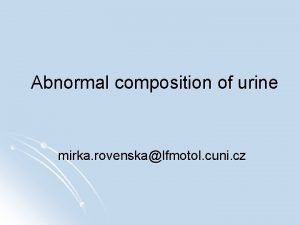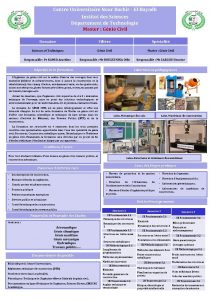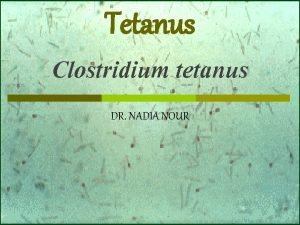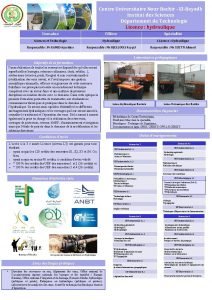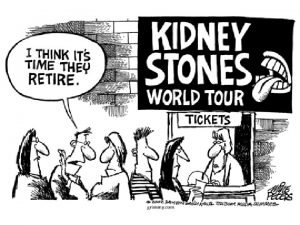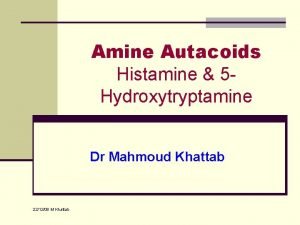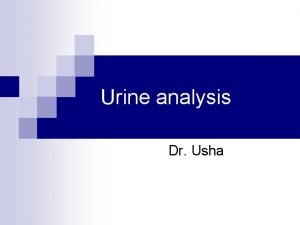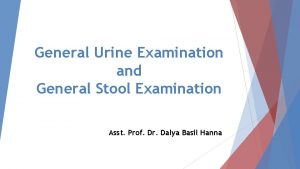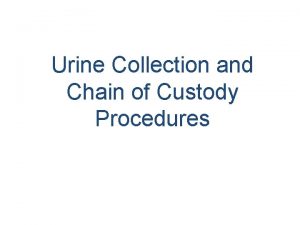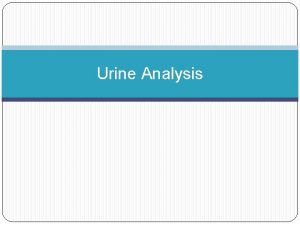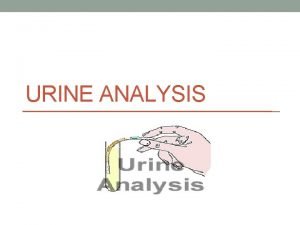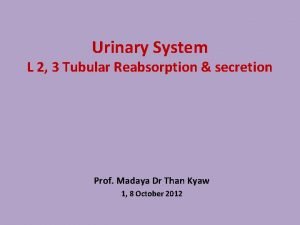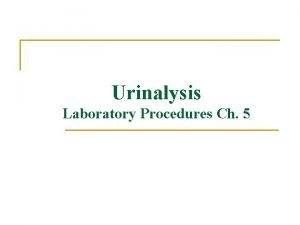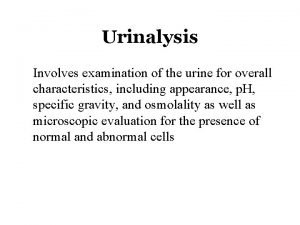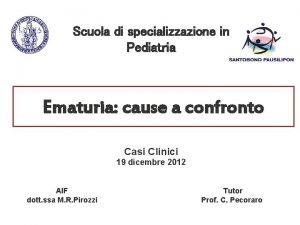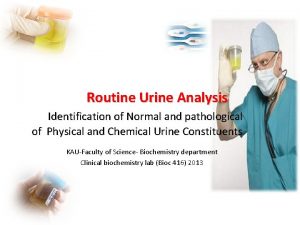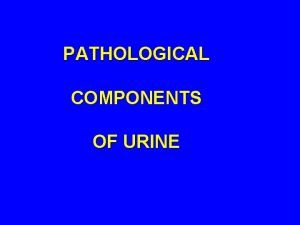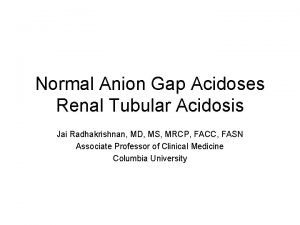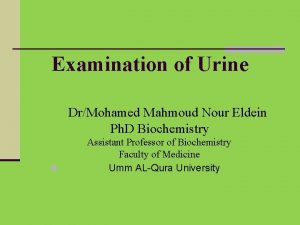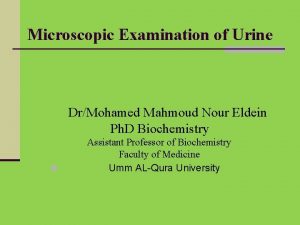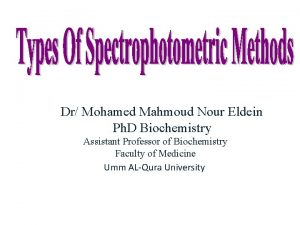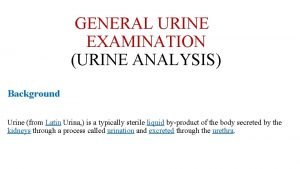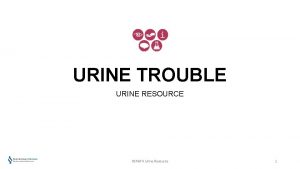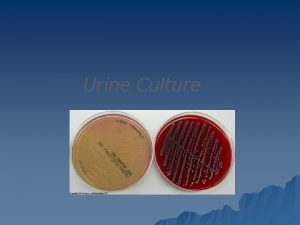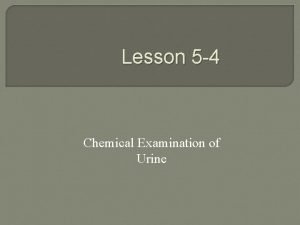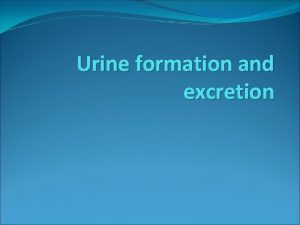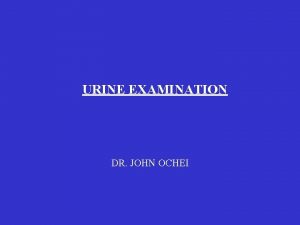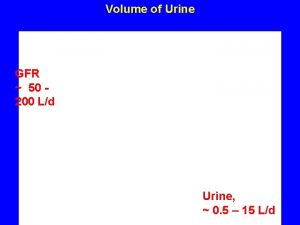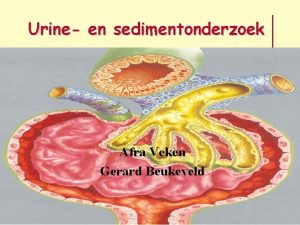Chemical analysis of Urine DrMohamed Mahmoud Nour Eldein
















































- Slides: 48

Chemical analysis of Urine Dr/Mohamed Mahmoud Nour Eldein Ph. D Biochemistry n Assistant Professor of Biochemistry Faculty of Medicine Umm AL-Qura University

Chemical Analysis

Urine dipsticks (Reagent Strips) n Urine dipstick are plastic strips on which are attached to a series of chemically impregnated absorbent pads, each pad contain certain chemicals that react with substance in the urine producing a color change in pad, this color change is compared with a series of known standards.

Chemical Analysis Urine Dipstick Glucose Bilirubin Ketones Specific Gravity Blood p. H Protein Urobilinogen Nitrite Leukocyte Esterase

Reagent Strips

Procedure n Reagent strips are used only once and discarded. n Testing n Perform within 1 hour after collection n Allow refrigerated specimens to return to room temperature. n Dip strip briefly, but completely into well mixed, room temperature urine sample. n Withdraw strip. n Blot briefly on its side. n Keep the strip flat, read results at the appropriate times by comparing the color to the appropriate color on the chart provided.

Procedure n Instruments are available which detect color changes electronically and prints out results

Handling and Storage of Strips n Handling and Storage n Keep strips in original container n Do not touch reagent pad areas n Reagents and strips must be stored properly to retain activity n n n Protect from moisture and volatile fumes Stored at room temperature Use before expiration date

Sources of Error n Timing - Failure to observe color changes at appropriate time intervals may cause inaccurate results. n Lighting - Observe color changes and color charts under good lighting. n QC - Reagent strips should be tested with positive controls on each day of use to ensure proper reactivity. n Sample - Proper collection and storage of urine is necessary to insure preservation of chemical.

Sources of Error n Testing cold specimens - would result in a slowing down of reactions; test specimens when fresh or bring them to RT before testing n Inadequate mixing of specimen - could result in false reduced or negative reactions to blood and leukocyte tests; mix specimens well before dipping n Over-dipping of reagent strip - will result in leaching of reagents out of pads; briefly, but completely dip the reagent strip into the urine

The Urine Dipstick: Negative Trace (100 mg/d. L) Glucose Chemical Principle Glucose Oxidase + (250 mg/d. L) Glucose + 2 H 2 O + O 2 ---> Gluconic Acid + 2 H 2 O 2 ++ (500 mg/d. L) Horseradish Peroxidase +++ (1000 mg/d. L) ++++ (2000+ mg/d. L) 3 H 2 O 2 + KI ---> KIO 3 + 3 H 2 O Read at 30 seconds RR: Negative

Uses and Limitations of Urine Glucose Detection Significance n n Diabetes mellitus. Renal glycosuria. Limitations n n n Interference: reducing agents, ketones. Only measures glucose and not other sugars. Renal threshold must be passed in order for glucose to spill into the urine. Other Tests n Cu. SO 4 test for reducing sugars.

Urinalysis Glucose Result Urine versus Blood Glucose ++ + trace Negative 200 400 600 800 Blood Glucose (mg/d. L) 1000

The Urine Dipstick: Bilirrubin Negative Chemical Principle + (weak) Acidic Azobilirubin Bilirubin + Diazo salt -----> ++ (moderate) +++ (strong) Read at 30 seconds RR: Negative

Bilirubin n Bilirubin is a byproduct of the breakdown of hemoglobin. n Normally contains no bilirubin. n Presence may be an indication of liver disease, bile duct obstruction or hepatitis. n Since the bilirubin in samples is sensitive to light, exposure of the urine samples to light for a long period of time may result in a false negative test result.

Ketones n Ketones are excreted when the body metabolizes fats incompletely (ketonuria)

The Urine Dipstick: Negative Ketones Chemical Principle Trace (5 mg/d. L) + (15 mg/d. L) ++ (40 mg/d. L) +++ (80 mg/d. L) ++++ (160+ mg/d. L) Acetoacetic Acid + Nitroprusside ------> Colored Complex Read at 40 seconds RR: Negative

Uses and Limitations of Urine Ketone Detection Significance - Diabetic ketoacidosis - Prolonged fasting Limitations - Interference: expired reagents (degradation with exposure to moisture in air) - Only measures acetoacetate not other ketone bodies (such as in rebound ketosis). Other Tests - Ketostix (more sensitive tablet version of same assay) - Serum glucose measurement to confirm DKA

Specific gravity n Depends on the concentration of various solutes in the urine. n Specific gravity reflects kidney's ability to concentrate. n Want concentrated urine for accurate testing, best is first morning sample. n Low – specimen not concentrated, kidney disease. n High – first morning, certain drugs n Measured by-urinometer - refractometer - dipsticks

Urinometer n Take 2/3 of urinometer container with urine n Allow the urinometer to float into the urine n Read the graduation at the lowest level of urinary meniscus n Correction of temperature & albumin is a must. n Urinometer is calibrated at 15 or 200 c So for every 3 oc increase/decrease add/subtract 0. 001 For 1 gm/dl of albumin add 0. 001

n

The Urine Dipstick: Specific Gravity 1. 000 1. 005 1. 010 1. 015 1. 020 1. 025 1. 030 Chemical Principle X+ + Polymethyl vinyl ether / maleic anhydride --------> X+-Polymethyl vinyl ether / maleic anhydride + H+ H+ interacts with a Bromthymol Blue indicator to form a colored complex. Read up to 2 minutes RR: 1. 003 -1. 035

Uses and Limitations of Urine Specific Gravity Significance - Diabetes insipidus Limitations - Interference: alkaline urine - Does not measure non-ionized solutes (e. g. glucose) Other Tests - Refractometry - Hydrometer - Osmolality measurement (typically used with water deprivation test)

High specific gravity(hyperosthenuria) n Normal-1. 016 -1. 022 n Causes All causes of oliguria Glycosuria

Low specific gravity(hyposthenuria) n All causes of polyuria except glycosuria n Fixed specific gravity (isosthenuria)=1. 010 Seen in chronic renal disease when kidney has lost the ability to concentrate or dilute

Blood n Presence of blood may indicate infection, trauma to the urinary tract or bleeding in the kidneys. n False positive readings most often due to contamination with menstrual blood.

The Urine Dipstick: Negative Trace (non-hemolyzed) Moderate (non-hemolyzed) Trace (hemolyzed) + (weak) ++ (moderate) +++ (strong) Blood Chemical Principle Lysing agent to lyse red blood cells Diisopropylbenzene dihydroperoxide + Tetramethylbenzidine Heme ------> Colored Complex Read at 60 seconds RR: Negative Analytic Sensitivity: 10 RBCs

Uses and Limitations of Urine Blood Detection Significance - Hematuria (nephritis, trauma, etc) - Hemoglobinuria (hemolysis, etc) - Myoglobinuria (rhabdomyolysis, etc) Limitations - Interference: reducing agents, microbial peroxidases - Cannot distinguish between the above disease processes Other Tests - Urine microscopic examination - Urine cytology

Urinary p. H/ reaction n Reaction reflects ability of kidney to maintain normal hydrogen ion concentration in plasma & ECF n Normal= 4. 6 -8 n Tested by- 1. litmus paper 2. p. H paper 3. dipsticks

The Urine Dipstick: p. H 5. 0 6. 5 7. 0 7. 5 8. 0 8. 5 Chemical Principle H+ interacts with: Methyl Red (at high concentration; low p. H) and Bromthymol Blue (at low concentration; high p. H), to form a colored complexes (dual indicator system) Read up to 2 minutes R. R. : 4. 5 -8. 0

Acidic urine n Ketosis-diabetes, starvation, fever n Systemic acidosis n UTI- E. coli n Acidification therapy

Alkaline urine n Strict vegetarian n Systemic alkalosis n UTI- Proteus n Alkalization therapy

Uses and Limitations of Urine p. H Detection Significance - Acidic (less than 4. 5): metabolic acidosis, high-protein diet - Alkaline (greater than 8. 0): renal tubular acidosis (>5. 5) Limitations - Interference: bacterial overgrowth (alkaline or acidic), “run over effect” effect of protein pad on p. H indicator pad Other Tests - Titrable acidity - Blood gases to determine acid-base status

p. H Run Over Effect Glucose Bilirubin Ketones Specific Gravity Blood p. H Protein Urobilinogen Nitrite Leukocyte Esterase Buffers from the protein area of the strip (p. H 3. 0) spill over to the p. H area of the strip and make the p. H of the sample appear more acidic than it really is.

Protein n Presence of protein (proteinuria) is an important indicator of renal disease. n False negatives can occur in alkaline or dilute urine or when primary protein is not albumin.

The Urine Dipstick: Negative Trace + (30 mg/d. L) Protein Chemical Principle “Protein Error of Indicators Method” Pr H Pr Pr H H Pr Pr Pr H + Tetrabromphenol Blue + ++ (100 mg/d. L) H+ H H (buffered to p. H 3. 0) + + H H +++ (300 mg/d. L) Pr Pr Pr ++++ (2000 mg/d. L) Pr Read at 60 seconds RR: Negative

Causes of Proteinuria Functional - Severe muscular exertion - Pregnancy - Orthostatic proteinuria Pre-Renal - Fever - Renal hypoxia - Hypertension Renal - Glomerulonephritis - Nephrotic syndrome - Renal tumor or infection Post-Renal - Cystitis - Urethritis or prostatitis - Contamination with vaginal secretions

Uses and Limitations of Urine Protein Detection Significance - Proteinuria and the nephrotic syndrome. Limitations - Interference: highly alkaline urine. - Much more sensitive to albumin than other proteins (e. g. , immunoglobulin light chains). Other Tests - Sulfosalicylic acid (SSA) turbidity test. - Urine protein electrophoresis (UPEP) - Bence Jones protein

Urobilinogen n Urobilinogen is a degradation product of bilirubin formed by intestinal bacteria. n It may be increased in hepatic disease or hemolytic disease

The Urine Dipstick: 0. 2 mg/d. L 1 mg/d. L Urobilinogen Chemical Principle Urobilinogen + Diethylaminobenzaldehyde (Ehrlich’s Reagent) 2 mg/d. L 4 mg/d. L 8 mg/d. L -------> Colored Complex Read at 60 seconds RR: 0. 02 -1. 0 mg/d. L

Uses and Limitations of Urobilinogen Detection Significance - High: increased hepatic processing of bilirubin - Low: bile obstruction Limitations - Interference: prolonged exposure of specimen to oxygen (urobilinogen ---> urobilin) - Cannot detect low levels of urobilinogen Other Tests - Serum total and direct bilirubin

Nitrite n Nitrite formed by gram negative bacteria converting urinary nitrate to nitrite

The Urine Dipstick: Nitrite Chemical Principle Negative Positive Acidic Nitrite + p-arsenilic acid -------> Diazo compound + Tetrahydrobenzoquinol -----> Colored Complex Read at 60 seconds RR: Negative

Uses and Limitations of Nitrite Detection Significance - Gram negative bacteriuria Limitations - Interference: bacterial overgrowth - Only able to detect bacteria that reduce nitrate to nitrite Other Tests - Correlate with leukocyte esterase and - Urine microscopic examination (bacteria) - Urine culture

Leukocytes n Leukocytes (white blood cells) usually indicate infection. n Leucocyte esterase activity is due to presence of WBCs in urine while nitrites strongly suggest bacteriuria.

The Urine Dipstick: Leukocyte Esterase Chemical Principle Negative Trace + (weak) ++ (moderate) +++ (strong) Derivatized pyrrole amino acid ester Esterases ------> 3 -hydroxy-5 -phenyl pyrrole + diazo salt -------> Colored Complex Read at 2 minutes RR: Negative Analytic Sensitivity: 3 -5 WBCs

Uses and Limitations of Leukocyte Esterase Detection Significance - Pyuria - Acute inflammation - Renal calculus Limitations - Interference: oxidizing agents, menstrual contamination Other Tests - Urine microscopic examination (WBCs and bacteria) - Urine culture

Normal Values n Negative results for glucose, ketones, bilirubin, nitrites, leukocyte esterase and blood. n Protein negative or trace. n p. H 5. 5 -8. 0 n Urobilinogen 0. 2 -1. 0 Ehrlich units
 Dari hasil tes ternyata urin pak yudha mengandung glukosa
Dari hasil tes ternyata urin pak yudha mengandung glukosa Leukocytes urine
Leukocytes urine Chemical analysis of urine
Chemical analysis of urine Passport by mahmoud darwish
Passport by mahmoud darwish Nour kadri
Nour kadri Centre universitaire nour bachir el-bayadh
Centre universitaire nour bachir el-bayadh Nadia nour
Nadia nour Centre universitaire nour el bachir el bayadh
Centre universitaire nour el bachir el bayadh Centre universitaire nour el bachir el bayadh
Centre universitaire nour el bachir el bayadh Nour el kadri
Nour el kadri Nour el kadri
Nour el kadri Nour fog
Nour fog Where is boar king
Where is boar king Characteristics of normal urine
Characteristics of normal urine Mahmoud abdelfattah age
Mahmoud abdelfattah age Salman mustafa
Salman mustafa Mahmoud arafa
Mahmoud arafa Mahmoud boudarene
Mahmoud boudarene Mahmoud sarmini md
Mahmoud sarmini md Adp antagonist drugs
Adp antagonist drugs Mahmoud khattab md
Mahmoud khattab md Hana mahmoud
Hana mahmoud Usha analysis
Usha analysis Trichomonas in urine
Trichomonas in urine Centrifuged
Centrifuged Chemical reactions section 2 classifying chemical reactions
Chemical reactions section 2 classifying chemical reactions Empirical formula and molecular formula pogil
Empirical formula and molecular formula pogil Chemical reactions section 2 classifying chemical reactions
Chemical reactions section 2 classifying chemical reactions Section 1 chemical changes
Section 1 chemical changes Chemical formulas and chemical compounds chapter 7
Chemical formulas and chemical compounds chapter 7 Chapter 18 chemical reactions balancing chemical equations
Chapter 18 chemical reactions balancing chemical equations Urine chain of custody form
Urine chain of custody form Urine contains
Urine contains Rbc
Rbc Normal specific gravity of urine
Normal specific gravity of urine Wbc cast
Wbc cast Characteristics of normal urine
Characteristics of normal urine Tommy chong urine luck
Tommy chong urine luck Proses pembentukan urine
Proses pembentukan urine Urine scure cause
Urine scure cause Ketones in urine moderate
Ketones in urine moderate Pipet tetes
Pipet tetes Fungsi sel jukstaglomerulus
Fungsi sel jukstaglomerulus Vin rose urine
Vin rose urine Physical composition of urine
Physical composition of urine Maple syrup urine disease amino acid
Maple syrup urine disease amino acid Type 4 rta
Type 4 rta Acute interstitial nephritis urine findings
Acute interstitial nephritis urine findings Pyel medical terminology
Pyel medical terminology


